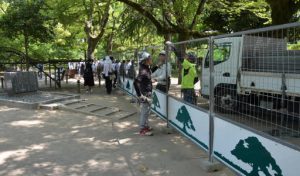Excavation of former Nakajima district begins for exhibition of A-bomb remains
May 17, 2019
(by Junji Akechi, Staff Writer)
On May 16, the City of Hiroshima began an excavation at the green belt located north of the Peace Memorial Museum’s east building with the aim of publicly exhibiting the remains of the former Nakajima district, which lies beneath the Hiroshima Peace Memorial Park in Naka Ward. The Nakajima district was completely annihilated by the atomic bomb. Based on the results of the exploratory excavation conducted last December, the city will examine the condition of the remains over a broader area than was pursued that previous time in order to determine the locations and the range of remains that will be shown to the public.
The excavation site is about 25 square meters in size and is located on the western side of the former Tenjin-machi-suji area, which was lined with lumber mills and private homes before the atomic bombing. It is close to the area where the preliminary excavation was carried out, and it is believed that the remains of houses, such as charred timbers and housewares that can convey how people lived their lives in the area prior to the atomic bombing, will be unearthed. On this day, in order to secure sufficient space for the excavation work, the city’s contractor enclosed an area of 20 meters by 20 meters with metal fencing. The actual excavation work will proceed on May 24.
The investigation will continue until late July and the results will be reported to the city’s advisory council comprised of experts and A-bomb survivors. After the council reviews the findings, the city may expand the area of excavation, as needed, for further investigation. Around July, citizens will be able to view the unearthed area directly.
The city plans to display the discovered remains of the district within fiscal year 2020. Haruaki Nakagawa, the head of the division charged with handing down the A-bomb experience to younger generations, said, “Through our excavation and investigation work, we would like to have the exhibition of these remains be informative for as many people as possible.”
(Originally published on May 17, 2019)
On May 16, the City of Hiroshima began an excavation at the green belt located north of the Peace Memorial Museum’s east building with the aim of publicly exhibiting the remains of the former Nakajima district, which lies beneath the Hiroshima Peace Memorial Park in Naka Ward. The Nakajima district was completely annihilated by the atomic bomb. Based on the results of the exploratory excavation conducted last December, the city will examine the condition of the remains over a broader area than was pursued that previous time in order to determine the locations and the range of remains that will be shown to the public.
The excavation site is about 25 square meters in size and is located on the western side of the former Tenjin-machi-suji area, which was lined with lumber mills and private homes before the atomic bombing. It is close to the area where the preliminary excavation was carried out, and it is believed that the remains of houses, such as charred timbers and housewares that can convey how people lived their lives in the area prior to the atomic bombing, will be unearthed. On this day, in order to secure sufficient space for the excavation work, the city’s contractor enclosed an area of 20 meters by 20 meters with metal fencing. The actual excavation work will proceed on May 24.
The investigation will continue until late July and the results will be reported to the city’s advisory council comprised of experts and A-bomb survivors. After the council reviews the findings, the city may expand the area of excavation, as needed, for further investigation. Around July, citizens will be able to view the unearthed area directly.
The city plans to display the discovered remains of the district within fiscal year 2020. Haruaki Nakagawa, the head of the division charged with handing down the A-bomb experience to younger generations, said, “Through our excavation and investigation work, we would like to have the exhibition of these remains be informative for as many people as possible.”
(Originally published on May 17, 2019)








